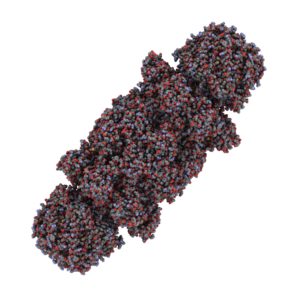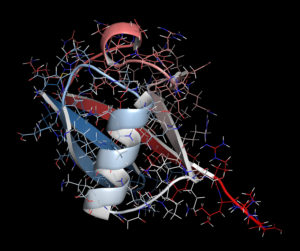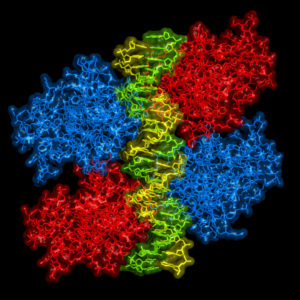
Ubiquitin modification of a protein directs events such as targeting for proteasomal degradation. Targeting a protein for degradation through ubiquitin modification is one way to regulate the amount of time a signaling protein, such as a kinase or other enzyme, is available to participate in cell signaling events. Deubiquitinases (DUBs) are enzymes that cleave the ubiquitin tags from proteins, and they have been implicated in several diseases, including cancer.
With their roles in the stabilization of proteins involved in cell cycle progression and other critical processes, DUBs are promising targets for small molecule inhibitors, particularly since they may provide a “back door” for targeting otherwise intractable, undruggable proteins by modulating their half lives. However, finding small molecule inhibitors of the ubiquitin proteases to date has not been trivial. Here we highlight two papers describing the identification and characterization of small molecule inhibitors against the DUB USP7.
Identifying DUB Inhibitors through High-Throughput Screens

The Ubiquitin-Specific Protease-7 (USP7) indirectly regulates the tumor suppressor protein p53. Specifically USP7 appears to “protect” the oncogenic E3 ligase protein, MDM2 from degradation. When MDM2 is degraded, the tumor suppressor, p53, is stabilized. Inhibition of USP7 results in degradation of MDM2, and stabilization of p53.
In a 2017 paper published in Nature, Kategaya et al. describe the identification and characterization of two selective USP7 inhibitors (GNE-6640 and GNE-6676). The researchers first identified the inhibitors through an “activity-based high-throughput screening cascade” in which they used NMR to identify USP7 catalytic domain binding fragments. Next a hit-to-lead series of screens was performed to select the most potent inhibitors and inform structural chemistry design. Two inhibitors were shown to enhance MDM2 ubiquination, while retaining specificity for USP7 over other USPs tested.
In a separate paper, also published in 2017, Turnbull and colleagues describe the isolation of two USP7 inhibitors through screening a 500,000-compound library using a fluorescent screen that monitored the cleavage of a ubiquitin-rhodamine substrate. The specificity and activity of these inhibitors was confirmed through a variety of biochemical activity assays.

Kategaya et al. showed that in cells, their USP7 inhibitors stabilized p53 protein and upregulated p21 protein expression. However, such effects were not observed in a p53-null or USP7-null background. These biochemical findings were further supported by cell viability studies using the CellTiter-Glo® Luminescent Cell Viability Assay showing that viability was decreased in the wild type but not the p53- or USP7-null cells.
After confirming the specificity of the two inhibitors for USP7 over other USPs and determining that the inhibitors worked in cells, the researchers prescreened 441 cell lines using 3-day viability assays, using the CellTiter-Glo® Assay. Negative control compounds showed no activity, but the two inhibitors both decreased viability of many of the cell lines. The long-term viability screen was repeated for an even longer incubation (5 days) with a subset of 185 cell lines. One inhibitor decreased viability of 54 cell lines; the other affected 6 cell lines. Combining viability data and exome sequencing revealed that Acute Myeloid Leukemia cell lines showed increased sensitivity to one of the inhibitors. Combining one of the inhibitors with the DNA damaging agents doxorubicin or cisplatin enhanced USP7 inhibitor activity, presumably because the p53 pathway was activated by these other agents.
Because inhibition was increased in the presence of cytotoxic agents, the researchers used a primary combination viability screen, again employing the CellTiter-Glo® Assay, as a method to identify signaling pathways that interact with USP7 activity. A library of 589 compounds arrayed in a nine-point dose response was screened in the presence or absence of either of the two USP7 inhibitors or the control compound at a fixed dose. From this screen the top hits were PI3K and PIM kinase inhibitors. Further investigation revealed that there is an intersection between USP7 DUB activity and PIM kinase in regulating cell viability.
In the other study, Turnbull and colleagues also confirmed their biochemical and structural studies with cell-based assays. They showed that treatment of cells with one of their USP7 inhibitors stabilized p53 protein and induction of p53 target gene expression (p21 and others). The CellTiter-Glo® Assay was used to show that the USP7 inhibitor FT671 blocks proliferation of MM.1S multiple myeloma cells. Cell culture results were also corroborated in vivo by studies indicating that FT671 treatment of mouse MM.1S xenographs resulted in dose-dependent inhibition of tumor growth.
Summary
Many proteins that are involved in cell cycle arrest, DNA repair and the “decisions” to undergo apoptosis or other forms of cell death prove intractable targets for small-molecule inhibitors, even though inhibitors appear highly effective in biochemical assays. It is possible that the Deubiquitinases will provide a back door to suppressing or enhancing the activities of these proteins that have previously proven undruggable, with properties that translate from biochemical assays to desired effects inside cells.
Literature Cited
- Kategaya, L. et al. (2017) USP7 small-molecule inhibitors interfere with ubiquitin binding. Nature 550, 534–8.
- Turnbull, A.P. et al. (2017) Molecular basis of USP7 inhibition by selective small-molecule inhibitors. Nature 550, 481–6.
Michele Arduengo
Latest posts by Michele Arduengo (see all)
- An Unexpected Role for RNA Methylation in Mitosis Leads to New Understanding of Neurodevelopmental Disorders - March 27, 2025
- Unlocking the Secrets of ADP-Ribosylation with Arg-C Ultra Protease, a Key Enzyme for Studying Ester-Linked Protein Modifications - November 13, 2024
- Exploring the Respiratory Virus Landscape: Pre-Pandemic Data and Pandemic Preparedness - October 29, 2024

One thoughtful comment